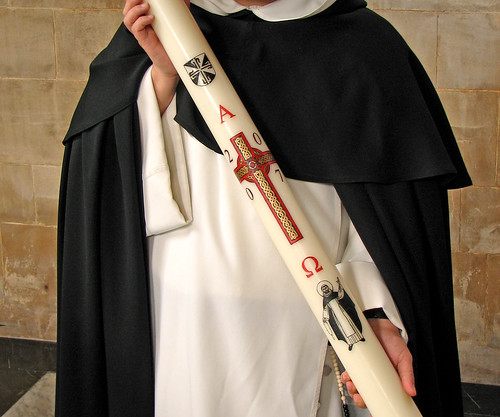Gospel reading: John 8:1-11
On the Easter Candle we write the Greek letters ‘Alpha’ and ‘Omega’ - the first and the last letters of the Greek alphabet - recalling that Christ is the beginning and the end, the eternal Son of the Father, who stoops down to humanity that we might be raised to enjoy eternal life with Him. From the silence of eternity, God stoops down and creates an orderly, meaningful, world - separating the light from the dark, the land from the water, man from beast - and filling this new cosmos with his own splendour. In the highest moment of creation, God crowns his work, by once again stooping down to the dust of the earth, to fashion from that inert clay the living Adam and Eve, who share in the very image and likeness of God. Finally, God ‘rests’ with his creation on the seventh day, a rest that has a saving significance, showing God as the God who is with us and for us.
The essence of sin is that it is opposed to creation: it is an un-creation. Into the orderly and beautiful world that God creates we insert our own chaos. We transgress the boundaries that God establishes for his glory and our own well-being, by building our own Towers of Babel to breach the divide between heaven and earth, or breaching the separation of humanity from the earth by treating our fellow citizens as if they were dirt. In the Book of Genesis, it is notable that as sin spreads, so does death: whilst Seth lives to be 912 (5:8), after the flood Peleg lives just 209 years (11:19). As an un-creation, sin is opposed to the purposes of creation, a choice for death rather than life to the full.
The woman in today’s gospel has been caught in a paradigm case of un-creation: her adultery is contrary to God’s law, fundamentally corroding the social structure of her community, running roughshod over the dignity of the participants as Children of God. Under the law, she is condemned to die. Her undoubted shame is compounded by the fact she has been caught in the very act, and - since her guilt is not in doubt under Jewish law - she has been witnessed by at least two unrelated adult men. Thrust before Christ, whom her accusers address as a Jewish leader, she will be expecting the worst, for she knows that her actions are contrary to the Jewish law. Yet, Christ sees not simply with the eyes of time but with those of eternity, and, remarkably, her guilt and shame is not met by words of condemnation, but the silence of God in Christ who, echoing the moment of creation, stoops down to touch the dust, and writes in the sand.
What is it that Christ writes, which causes the woman’s accusers to abandon the certain prosecution for the death penalty? Tradition suggests it is the sins of the accusers, revealed and laid bare so that they realise that they too have opted for death over the life that God offers. In the Book of Daniel, the hand of God appears and writes “MENE, MENE, TEKEL, PARSIN” on the wall during Belshazzar’s feast, signifying that “God has numbered the days of your kingdom […] you have been weighed and found wanting […] your Kingdom is divided” (Daniel 5:25-28). In the Prophecies of Jeremiah, we hear of those who have turned away from the Lord being “written in the earth” (17:13). Whatever it is that he writes, Christ’s action reminds us that it is God, and not man, who is the ultimate judge.
Jesus speaks only once the accusers have scattered. In remitting the woman’s death penalty, he establishes once again the priority of life over death. These words, however, are not simply the pronouncements of a merciful judge who opts in his infinite discretion not to punish. Like the words of God recorded in Genesis 1, Christ’s words are not simple descriptions, but are re-creative, fashioning and calling into existence a new reality. It is these all powerful words of re-creation that meet our acts of un-creation, healing and restoring us, elevating us to the end for which God created in the first place, to eternally enjoy communion with him, that he might delight in us, and we delight in him.


very good. enjoyed reading this. very well done.
ReplyDelete